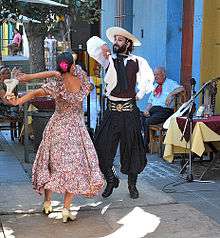Zamba (artform)

Zamba is a traditonal dance of Argentina. It is a style of Argentinian music and Argentinian folk dance. Zamba is very different from its homophone, the samba - musically, rhythmically, temperamentally, in the steps of the dance and in its costume. It has six beats to the bar and is a majestic dance, performed by couples who circle each other waving white handkerchiefs very elegantly. It has common elements with the cueca.
Zambas are composed about every genre, from those that celebrate people or events of Argentinian history, to those that describe the beauty of a region, or of its women. There are zambas of political protest, and even one called Aerolíneas Argentinas. The bombo legüero drum is prominent in the playing of the zamba.
Name and Origin
The name "zamba" refers to a colonial term for zambo (descendants of European Spanish, Amerindian mixed with African people). It is therefore called zamba because its lyrical content was aimed at its native listeners.
The dance originated in the Argentine province of Tucuman in the Creole genre known as the zamacueca of Peru, in 1824 at the same time that Peru, under José de San Martín, obtained independence. It came to Argentina through "Alto Peru," a region that is modern day Bolivia and through Chile between 1825 and 1830.[1][2]
Description
The Zamba is a slow dance in three-quarter time played primarily on guitar and bombo legüero. The steps of the dance are a walking step, an alternate step (two steps at one time), and a tip toe alternate step or "sobrepaso punteado" (three steps at one time). The Zamba also requires a handkerchief.
Today
Today Zamba is frequently danced in the streets of Argentina and always danced in Argentine folklore parties and festivals.It is performed during the national holidays of Argentina.
References
- ↑ La primera descripcion coreográfica completa documentada de la zamacueca se encuentra en "Mefistófeles" año 1 Nº22 "Aires Nacionales" del folclorólogo Arturo Berrutti, publicado en Buenos Aires el 29 de julio de 1882; Berrutti, Arturo (29 July 1882). Aires Nacionales (in Spanish). Mefistófeles.
- ↑ Aricó, Hector (2002). Danzas Tradicionales Argentinas -Una Nueva Propuesta- (in Spanish). Vilco SRL. ISBN 987-43-4537-3.
External links
- (English) Strum guitar for Zamba
- Boleadora.com